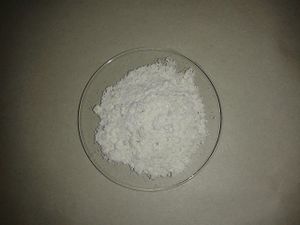Calcium hypochlorite
 OTC calcium hypochlorite
| |
| Names | |
|---|---|
| IUPAC name
Calcium hypochlorite
| |
| Other names
Bleaching powder
Calcium oxychloride | |
| Properties | |
| Ca(OCl)2 | |
| Molar mass | 142.98 g/mol |
| Appearance | White-gray powder |
| Density | 2.35 g/cm3 (20 °C) |
| Melting point | 100 °C (212 °F; 373 K) (displays decomposition) |
| Boiling point | 175 °C (347 °F; 448 K) (decomposition) |
| 21 g/100 ml (will slowly hydrolyze) | |
| Solubility | Reacts with alcohols, ketones |
| Hazards | |
| Safety data sheet | Sigma-Aldrich |
| Flash point | Non-flammable |
| Lethal dose or concentration (LD, LC): | |
| LD50 (Median dose)
|
850 mg/kg (rat, oral) |
| Related compounds | |
| Related compounds
|
Lithium hypochlorite Sodium hypochlorite Potassium hypochlorite |
| Except where otherwise noted, data are given for materials in their standard state (at 25 °C [77 °F], 100 kPa). | |
| Infobox references | |
Calcium hypochlorite (Ca(OCl)2) is a strong oxidizer used to chlorinate swimming pools. As a solid, it is a much more concentrated source of the hypochlorite ion than sodium hypochlorite, since it is stable as a solid and can be sold as such.
Contents
Properties
Chemical
Calcium hypochlorite often undergoes violent reactions due to its highly oxidizing nature. A common demonstration of this is the the reaction between calcium hypochlorite and 'brake fluid' (a mixture of easily-oxidizable glycol ethers), a slurry of which spontaneously bursts into flames after a few seconds. This reaction also works with many other simple alcohols and polyols like glycerol and some sugars. This is similar to the reaction of potassium permanganate with the same substances, however, the free chlorine and chlorinated by-products produced by the reaction with hypochlorite makes the latter much more hazardous.
Strong acids react with the hypochlorite to produce chlorine. Typically, aqueous HCl is dripped slowly onto powdered hypochlorite, generating a steady stream of wet chlorine gas.
- Ca(OCl)2 + 4 HCl → 2 Cl2 + CaCl2 + 2 H2O
Caution must be taken as the reaction is very exothermic and may generate foam.
Concentrated solutions of calcium hypochlorite will attack and bleach filter paper.
Physical
Calcium hypochlorite is a white, fairly soluble solid that makes mixtures burn with a red flame due to the calcium ion. It smells strongly of chlorine. It is commonly sold as a solid mixture with calcium carbonate.
Availability
Often available as a 'shock chlorinator' for swimming pools, in a variety of different purities depending on the brand. Most of the time, the store-grade calcium hypochlorite contains many impurities and has a "dirty" aspect.
Preparation
Preparation is not often done since Ca(OCl)2 is easily available, but can be done by bubbling chlorine gas through a calcium hydroxide solution.
Projects
- Producing chlorine gas
- Making singlet oxygen
- Making calcium chlorate
Handling
Safety
Calcium hypochlorite is not good for skin or eyes as it is very bleaching and very oxidizing. Violent reactions occur with many compounds, which generally result in toxic chlorine gases. As with bleach, do not allow calcium hypochlorite or a solution of it to touch artificially colored clothing, as it will bleach it.
Storage
Best stored in closed containers or in bottles kept inside plastic bags to reduce the chlorine from leaking.
Disposal
Can be simply poured down the drain or neutralized first with a sulfite or metabisulfite salt.
References
Tdep - experience working with this solid, which I generally try to avoid now if I can ever since it once destroyed a very nice pair of red shoes I had.